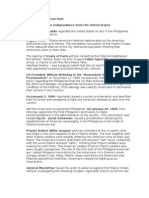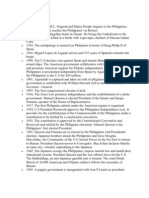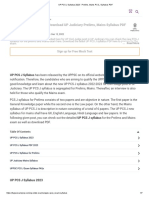Path To War
Path To War
Uploaded by
aki kiaCopyright:
Available Formats
Path To War
Path To War
Uploaded by
aki kiaOriginal Title
Copyright
Available Formats
Share this document
Did you find this document useful?
Is this content inappropriate?
Copyright:
Available Formats
Path To War
Path To War
Uploaded by
aki kiaCopyright:
Available Formats
Path to war
[edit]
The First Philippine Republic was declared on January 21, 1899. [100] Lack of
recognition by the United States led to rising tensions and, eventually, to hostilities.
On January 31, 1899, the Minister of Interior of the Republic, Teodoro Sandiko,
signed a decree saying that President Aguinaldo had directed that all idle lands be
planted to provide food, in view of impending war with the Americans. [101]
On the evening of February 4, Private William W. Grayson fired the war's first shots
along Sociego Street towards a sub-post of blockhouse 7 located at the turn towards
the blockhouse.[102][d] A study done by Ronnie Miravite Casalmir places this spot at
the corner of Sociego Street and Tomas Arguelles Street, not at the corner of
Sociego-Silencio.[102] According the National Historical Commission of the Philippines,
two unarmed soldiers were killed.[104] According to Grayson's account, his patrol
ordered four Filipino soldiers to "Halt!" and, when the men responded by cocking
their rifles, they fired on them and then retreated. [105][e] The outbreak of violence
triggered the 1899 Battle of Manila. Later that day, Aguinaldo declared "That peace
and friendly relations with the Americans be broken and that the latter be treated as
enemies, within the limits prescribed by the laws of war." [107]
Historical marker installed by the Philippines Historical
Committee in 1941 to commemorate the shot that started the war
The following day, Filipino General Isidoro Torres came through the lines under a flag
of truce to deliver a message from Aguinaldo to General Otis that the fighting had
begun accidentally, and that Aguinaldo wished for the hostilities to cease
immediately and for the establishment of a neutral zone. Otis dismissed these
overtures, and replied that the "fighting, having begun, must go on to the grim
end".[108] On February 5, General Arthur MacArthur ordered his troops to advance
against Filipino troops.[109]
Wounded American soldiers at Santa Mesa, Manila in
1899
In the U.S., President McKinley had created a commission chaired by Jacob G.
Schurman on January 20[f] and tasked it to study the situation in the Philippines and
make recommendations on how the U.S. should proceed. Members included General
Otis and two other civilian appointees. The three civilian members of the
commission arrived in Manila on March 4, 1899, a month after hostilities began. [110]
General Otis viewed the arrival of his fellow commission members as an intrusion
and boycotted commission meetings.[111] The civilian members of the commission
spent a month meeting with Ilustrados who had deserted Aguinaldo's Malolos
Republic government and studying the Malolos Constitution and other documents of
Aguinaldo's revolutionary government. Meanwhile, with U.S. forces advancing
northwards from Manila, the seat of Aguinaldo's revolutionary government had been
moved from Malolos to San Isidro, Nueva Ecija. When Malolos fell at the end of
March, it moved further north to San Fernando, Pampanga.[112]
The commission published a proclamation containing assurances that the U.S. did
not intend exploitation of Filipinos, but their "advancement to a position among the
most civilized peoples of the world", and announced "that the United States is ...
anxious to establish in the Philippine Islands an enlightened system of government
under which the Philippine people may enjoy the largest measure of home rule and
the amplest liberty."[113]
Though not authorized to discuss an armistice, civilian commission members held
informal discussions with a representative of Aguinaldo. Progress on a path without
war ended after General Luna arrested Aguinaldo's then-cabinet and replaced it with
a more hawkish one headed by Apolinario Mabini. [g] On June 2, 1899, the First
Philippine Republic declared war on the United States. [114]
American strategy
[edit]
The Battle of Caloocan, February 10, 1899. Major
General Arthur MacArthur with binoculars at the front line.
American annexation was justified in the name of liberating and protecting the
peoples in the former Spanish colonies. Senator Albert J. Beveridge, a prominent
American imperialist, said: "Americans altruistically went to war with Spain to
liberate Cubans, Puerto Ricans, and Filipinos from their tyrannical yoke. If they
lingered on too long in the Philippines, it was to protect the Filipinos from European
predators waiting in the wings for an American withdrawal and to tutor them in
American-style democracy."[115]
On February 11, 1899, one week after the first shots were fired, Iloilo was
bombarded by American naval forces from the USS Petrel (PG-2) and
the USS Baltimore (C-3). Filipino forces lit the town on fire before retreating. The city
was captured by ground forces led by Brigadier General Marcus Miller, with no loss
of American lives. 25 to 30 Filipinos were wounded. The "native" part of the city was
almost entirely destroyed.[116]
Months later, after finally securing Manila, American forces moved northward,
engaging in combat at the brigade and battalion level in pursuit of the fleeing
insurgent forces.[117] In response to the use of guerrilla warfare tactics by Filipino
forces, beginning in September 1899,[118] American military strategy shifted to
suppression of the resistance. Tactics became focused on the control of key areas
with internment and segregation of the civilian population in "zones of protection"
from the guerrillas.[119] Many of the interned civilians died from dysentery.[120]
General Otis gained notoriety for some of his actions. Although his superiors had
directed Otis to avoid military conflict, he did little to prevent war. Otis refused to
accept anything but unconditional surrender from the Philippine Army. He often
made major military decisions without first consulting Washington. He acted
aggressively in dealing with the Filipinos under the assumption that their resistance
would collapse quickly.[121] Even after this assumption proved false, he continued to
insist that the insurgency had been defeated, and that the remaining casualties
were caused by "isolated bands of outlaws". [122]
Otis was also active in suppressing information about American military tactics.
When letters describing American atrocities reached the American media, Otis had
each press clipping forwarded to the original writer's commanding officer, who
would convince or force the soldier to retract his statements. [123]
Filipino strategy
[edit]
20th Kansas Volunteers marching through Caloocan at
night, 1899
Estimates of the Filipino forces vary between 80,000 and 100,000, with tens of
thousands of auxiliaries. Most of the forces were armed only with bolo knives, bows
and arrows, spears, and other primitive weapons, which were vastly inferior to the
guns and other weapons of the American forces. [124]
A fairly rigid indigenous caste system existed in the Philippines before the Spanish
colonial era, which partially survived among the natives during Spanish rule. The
goal, or end-state, sought by the First Philippine Republic was a sovereign,
independent, stable nation led by an oligarchy composed of members of
the educated class (known as the ilustrado class). Local chieftains, landowners,
businessmen, and cabezas de barangay were the principales who controlled local
politics. The war was at its peak when ilustrados, principales, and peasants were
unified in opposition to annexation by the United States. The peasants, who
represented the majority of the fighting forces, had interests different from
their ilustrado leaders and the principales of their villages. Coupled with
the ethnic and geographic fragmentation, aligning the interests of people from
different social castes was a daunting task. [125] The challenge for Aguinaldo and his
generals was to sustain unified Filipino public opposition; this was the
revolutionaries' strategic center of gravity.[126]
The Filipino operational center of gravity was the ability to sustain its force of
100,000 irregulars in the field. The Filipino general Francisco Macabulos described
the Filipinos' war aim as, "not to vanquish the U.S. Army but to inflict on them
constant losses". In the early stages of the war, the Philippine Revolutionary Army
employed the conventional military tactics typical of an organized armed resistance.
The hope was to inflict enough American casualties to result in McKinley's defeat
by William Jennings Bryan in the 1900 presidential election. They hoped that Bryan,
who held strong anti-imperialist views, would withdraw the American forces from
the Philippines.[127]
McKinley's election victory in 1900 was demoralizing for the insurgents, and
convinced many Filipinos that the United States would not depart quickly.
[127]
Coupled with a series of devastating losses on the battlefield against American
forces equipped with superior technology and training, Aguinaldo became
convinced that he needed to change his approach. Beginning on September 14,
1899, Aguinaldo accepted the advice of General Gregorio del Pilar and authorized
the use of guerrilla warfare tactics in subsequent military operations in Bulacan. [118]
You might also like
- Filipino-American War: By: Arnaldo DumindinDocument13 pagesFilipino-American War: By: Arnaldo DumindinJezreel Sumagang100% (1)
- The Filipino-American HostilitiesDocument14 pagesThe Filipino-American HostilitiesPhang Longakit Añora100% (3)
- GROUP 7 Filipino Grievances Against Governor WoodDocument26 pagesGROUP 7 Filipino Grievances Against Governor WoodMicon Dumip-ig CamingawanNo ratings yet
- Lesson 1.3 The Philippine American War 1Document7 pagesLesson 1.3 The Philippine American War 1IvyNo ratings yet
- History Chap 7Document15 pagesHistory Chap 7Isabel FlonascaNo ratings yet
- Chapter 7 World HXDocument10 pagesChapter 7 World HXJela Valencia100% (1)
- Reading PHDocument6 pagesReading PHEzra CalayagNo ratings yet
- The Filipino-American HostilitiesDocument2 pagesThe Filipino-American HostilitiesJoelle Noriko G. Galang100% (5)
- Inbound 84930087951725618Document5 pagesInbound 84930087951725618ninacristoria87No ratings yet
- Lessons From Philippines Counter Insurgency 1899Document16 pagesLessons From Philippines Counter Insurgency 1899everlord123No ratings yet
- The American Rule: 1. War of Philippine Independence From The United StatesDocument18 pagesThe American Rule: 1. War of Philippine Independence From The United StatesIsabel FlonascaNo ratings yet
- The Spanish American WarDocument98 pagesThe Spanish American WarVeinna Yein Abansado AdaroNo ratings yet
- Filipino-American WarDocument43 pagesFilipino-American WarGenicaStaCruz100% (1)
- Guerrilla War PhaseDocument4 pagesGuerrilla War Phaseaki kiaNo ratings yet
- Chapter 6: The American PeriodDocument6 pagesChapter 6: The American Periodjoseph5689No ratings yet
- American War in The PHDocument5 pagesAmerican War in The PHmypatchieeNo ratings yet
- Americanrule Cheena ArcegaDocument24 pagesAmericanrule Cheena ArcegaAshley Joy Delos ReyesNo ratings yet
- Battle: Filipino PreparationsDocument2 pagesBattle: Filipino PreparationsMyra GarciaNo ratings yet
- Philippine American WarDocument5 pagesPhilippine American Warclarisse jaramillaNo ratings yet
- Philippine American WarDocument5 pagesPhilippine American WarMiguel AglipayNo ratings yet
- American ColonizationDocument10 pagesAmerican ColonizationJefferson BoadillaNo ratings yet
- Phil Histo Learning Unit 10Document5 pagesPhil Histo Learning Unit 10Ma Winda LimNo ratings yet
- The Philippine Under The American and Japanese RuleDocument39 pagesThe Philippine Under The American and Japanese RuleJoryl Shane Matero RamirezNo ratings yet
- Philippine American WarDocument11 pagesPhilippine American WarLily DuganonNo ratings yet
- All PPT RPHDocument302 pagesAll PPT RPHEloisa MontibonNo ratings yet
- The Filipino-American HostilitiesDocument11 pagesThe Filipino-American HostilitiesRodrick Sonajo RamosNo ratings yet
- Philippine RevolutionDocument6 pagesPhilippine RevolutionAngelo Otañes GasatanNo ratings yet
- The Last To Surrender: General Miguel MalvarDocument4 pagesThe Last To Surrender: General Miguel MalvarRoda May DiñoNo ratings yet
- American Occupatio N: Report By: Karel Gascon Rachelle Go Ronstadt Lee Igel ManaloDocument82 pagesAmerican Occupatio N: Report By: Karel Gascon Rachelle Go Ronstadt Lee Igel ManaloKarel GasconNo ratings yet
- Inbound 1617207554425340071Document6 pagesInbound 1617207554425340071ninacristoria87No ratings yet
- PH RevolutionDocument5 pagesPH RevolutionDhang CalumbaNo ratings yet
- Filipino American AnimosityDocument8 pagesFilipino American AnimosityApril CaringalNo ratings yet
- Learning Module: Surigao State College of TechnologyDocument11 pagesLearning Module: Surigao State College of TechnologyUgh AeshaNo ratings yet
- The Arrival of The AmericansDocument7 pagesThe Arrival of The AmericansmacemarmitoNo ratings yet
- American RegimeDocument6 pagesAmerican RegimeKim Almario MerleNo ratings yet
- American Colonial Period: The Provincial and Municipal Elites of Luzon During The Revoution, 1898-1902Document4 pagesAmerican Colonial Period: The Provincial and Municipal Elites of Luzon During The Revoution, 1898-1902Danica Shane EscobidalNo ratings yet
- 5-THE PHILIPPINE AMERICAN WAR-EAC - PPT-TEMPLATE-updated-as-of-03.20.21 PDFDocument95 pages5-THE PHILIPPINE AMERICAN WAR-EAC - PPT-TEMPLATE-updated-as-of-03.20.21 PDFBABY GRACE ABADNo ratings yet
- Timeline of American OccupationDocument3 pagesTimeline of American OccupationHannibal F. Carado100% (3)
- Bryan Arellano Professor Christopher Figuerroa Readings in Phillipine History SCHEDULE: TH 1:00PM - 4:00PMDocument12 pagesBryan Arellano Professor Christopher Figuerroa Readings in Phillipine History SCHEDULE: TH 1:00PM - 4:00PMkeithNo ratings yet
- April 22Document23 pagesApril 22Erk WorldNo ratings yet
- Chapter 10 The Filipino-American AnimosityDocument23 pagesChapter 10 The Filipino-American AnimosityApril Caringal100% (3)
- American Period NotesDocument29 pagesAmerican Period NotesElvy De JesusNo ratings yet
- Filipino American RelationsDocument20 pagesFilipino American Relationsgustokongmaginghatdog2.1100% (2)
- American Period in PhilDocument23 pagesAmerican Period in Philjulesubayubay5428100% (1)
- Filipino American HostilitiesDocument9 pagesFilipino American HostilitiesElizabeth VasquezNo ratings yet
- Quarter 2 Lesson 1 APDocument7 pagesQuarter 2 Lesson 1 APShakira Lyza KeeNo ratings yet
- For FINAL Reading Philippine History SummaryDocument6 pagesFor FINAL Reading Philippine History Summaryfardz22computerNo ratings yet
- PPTXDocument40 pagesPPTXSheila Grace BajaNo ratings yet
- Capture of AguinaldoDocument3 pagesCapture of AguinaldoRenzo SantiagoNo ratings yet
- Philippine Military HistoryDocument45 pagesPhilippine Military Historymathrackers7No ratings yet
- The Balangiga MassacreDocument7 pagesThe Balangiga MassacreRochelle LluzNo ratings yet
- Chapter 8 GDocument23 pagesChapter 8 GbejanojellaNo ratings yet
- Phil Histo Learning Unit 9Document4 pagesPhil Histo Learning Unit 9Ma Winda LimNo ratings yet
- For Malolos ConstitutionDocument40 pagesFor Malolos ConstitutionslotwaniiNo ratings yet
- Filipino Americanwar 140915182933 Phpapp02Document40 pagesFilipino Americanwar 140915182933 Phpapp02Jomar Panimdim BalamanNo ratings yet
- Aguinaldo Declaration of War Primary ResourcesDocument7 pagesAguinaldo Declaration of War Primary ResourcesGABRIEL MAYNIGONo ratings yet
- RPH ReportDocument7 pagesRPH Reportvincentdajao20No ratings yet
- NotesDocument7 pagesNotesBryan Simone AbaigarNo ratings yet
- Assginment Reading in Philippine HistoryDocument2 pagesAssginment Reading in Philippine HistoryHuey CalabinesNo ratings yet
- The Coming of United StatesDocument14 pagesThe Coming of United Statesmaricel cuisonNo ratings yet
- Excel Exercise 1: A B C D E 1 2 Vote 3 Clinton 4 5 Bush 6 7 Perot 8 9 TotalDocument4 pagesExcel Exercise 1: A B C D E 1 2 Vote 3 Clinton 4 5 Bush 6 7 Perot 8 9 TotalAbhinav RajNo ratings yet
- G.R. No. 115844Document10 pagesG.R. No. 115844a aNo ratings yet
- 2014 Undg Hact FrameworkDocument143 pages2014 Undg Hact FrameworkBilguun WorkaholicNo ratings yet
- Land Expropriation Without Compensation To Be Done Within Limits'Document144 pagesLand Expropriation Without Compensation To Be Done Within Limits'Sine MadoloNo ratings yet
- Admin LawDocument25 pagesAdmin LawTats YumulNo ratings yet
- Education For TransgenderDocument15 pagesEducation For TransgenderPoulomi Mandal100% (1)
- 1963 Newspaper Clippings School Desegregation Part 4Document181 pages1963 Newspaper Clippings School Desegregation Part 4Englewood Public Library100% (2)
- RekoDocument65 pagesRekobuyersstrikewpNo ratings yet
- 10th To 16th Philippine PresidentsDocument5 pages10th To 16th Philippine Presidentsglaide lojeroNo ratings yet
- DocumentDocument3 pagesDocumentSom Dutt VyasNo ratings yet
- R.12-12-011 - Uber Application For Rehearing of Decision 13-09-045 PDFDocument7 pagesR.12-12-011 - Uber Application For Rehearing of Decision 13-09-045 PDFLiz GannesNo ratings yet
- Toward Renewed Legitimacy? Nuclear Power, Global Warming, and SecurityDocument19 pagesToward Renewed Legitimacy? Nuclear Power, Global Warming, and SecurityAsha RaniNo ratings yet
- Pagibig Member S Data Form MDFDocument7 pagesPagibig Member S Data Form MDFWilma OcampoNo ratings yet
- Current Affairs Jan-Dec 2020.Document545 pagesCurrent Affairs Jan-Dec 2020.Shubham ranjanNo ratings yet
- White Book 2 DelDocument92 pagesWhite Book 2 DelMark ThompsonNo ratings yet
- Naming Renaming of SchoolsDocument2 pagesNaming Renaming of SchoolsTeresa Mae AlaonNo ratings yet
- XXXXXXDocument8 pagesXXXXXXEuj P. CabalanNo ratings yet
- African Renewal, African RenaissanceDocument24 pagesAfrican Renewal, African RenaissanceDaniel Machado da ConceiçãoNo ratings yet
- The Colony Marijuana Arrests in 2007Document6 pagesThe Colony Marijuana Arrests in 2007Texas Marijuana Arrest MapsNo ratings yet
- KSA Fines For Providing Online Gambling Services in The NetherlandsDocument3 pagesKSA Fines For Providing Online Gambling Services in The NetherlandsMark van WeerenNo ratings yet
- Intro To The Oakes TestDocument10 pagesIntro To The Oakes Testapi-241505258No ratings yet
- Annexure 01 Cctns UpDocument120 pagesAnnexure 01 Cctns UpconsultmiplNo ratings yet
- Supreme Court Age 65Document48 pagesSupreme Court Age 65AttaNo ratings yet
- UP PCS J Syllabus 2023 - Prelims, Mains PCS J Syllabus PDFDocument7 pagesUP PCS J Syllabus 2023 - Prelims, Mains PCS J Syllabus PDFmohit kumarNo ratings yet
- Application For Loan Scheme of JSMFDCDocument5 pagesApplication For Loan Scheme of JSMFDCDhanesh KumarNo ratings yet
- Lesson 1 (Rizal Law and The Advent of A National Hero)Document4 pagesLesson 1 (Rizal Law and The Advent of A National Hero)RraineeRoss UnNo ratings yet
- Reso#33 - Supproting DILG Memo 2023-074Document2 pagesReso#33 - Supproting DILG Memo 2023-074naugsolfarmersassociationNo ratings yet
- Trade Union Act - DumpDocument41 pagesTrade Union Act - DumpjateelNo ratings yet
- Department of HealthDocument3 pagesDepartment of HealthVins CosteloNo ratings yet

























































































